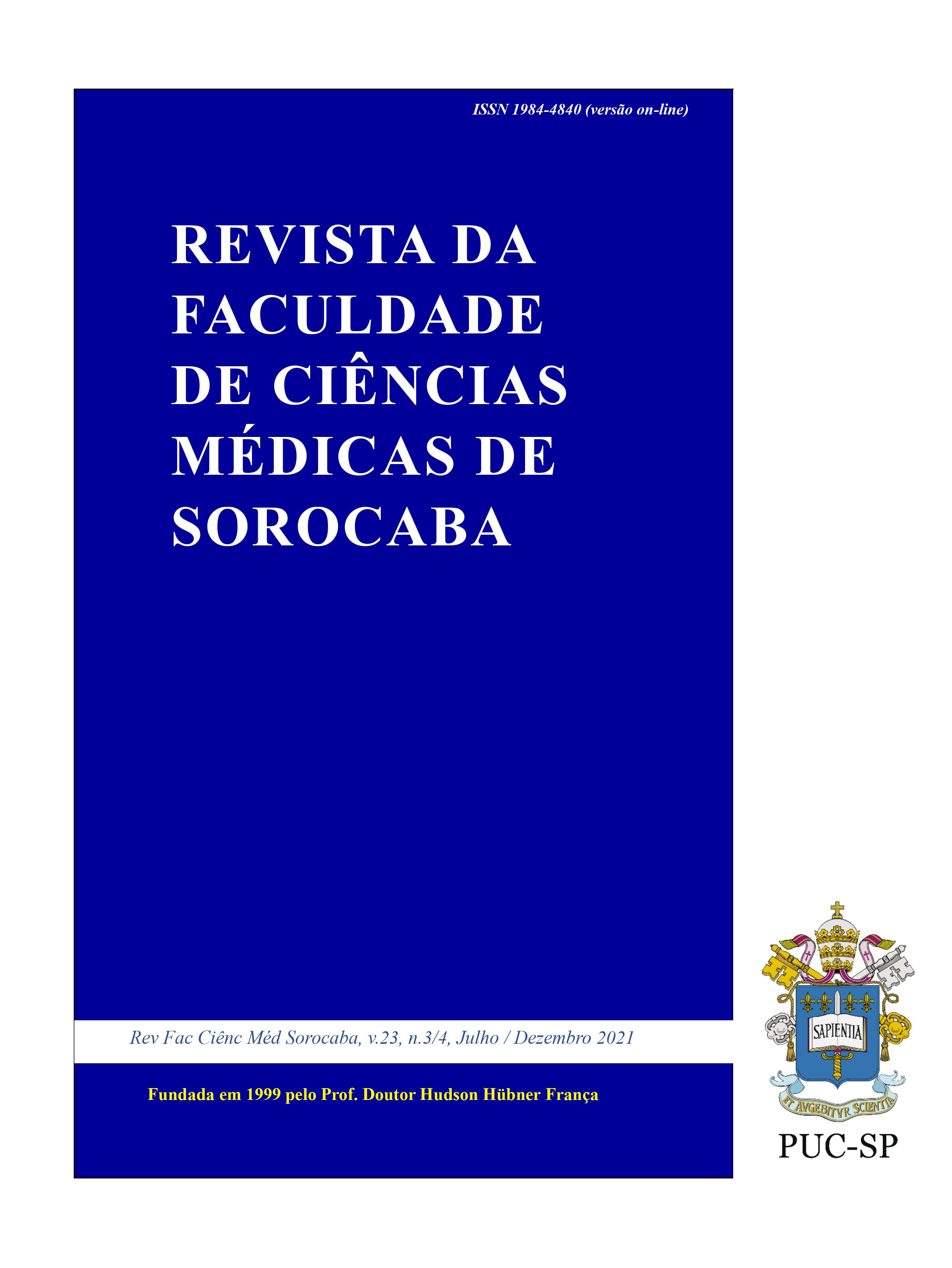Prevalence of anxiety and depression in a class of medicine students with remote teaching
DOI:
https://doi.org/10.23925/1984-4840.2021v23i3/4a6Keywords:
medical students, anxiety, depression, education, distance, COVID-19Abstract
Objective: to identify the prevalence of anxiety and depression in remote medical students and possible associated factors. Methods: observational study with a cross-sectional design in students of the first period of the Medicine course at the Federal University of Piauí\CSHNB in the year 2021, which worked entirely remotely due to the period of the COVID-19 pandemic. Data were collected through the application of an anonymous online questionnaire, after approval by CEP\UFPI. Results: twenty second-year medical students with a mean age of 21 years (±3.1; SD) were evaluated. The prevalence of anxiety was 65%, while depression was 30%. Among individuals with anxiety, men prevailed, being of brown color, from other states, who live with family members/spouses, with a steady partner, with an affinity for some religion, who used alcohol or illicit drugs and did not use medication for anxiety, however, with statistical significance (p<0.05) only biological sex and having a steady partner. Among the students with suspected depression, those who were male, brown, from other states, living with relatives, with religious affinity, who did not use medication for depression and who used alcohol or illicit drugs prevailed, with no significant difference. Final Considerations: a high prevalence of signs of anxiety and depression was evidenced in students of a remote medicine class. The main limitation of the study was the reduced number of participants.
References
Cavestro MJ, Rocha FL. Prevalência de depressão entre estudantes universitários. J Bras Psiquiatr. 2006;55(4):264-7. doi: 10.1590/S0047-20852006000400001
Rodrigues DG, Pelisoli C. Ansiedade em vestibulandos: um estudo exploratório. Arch Clin Psychiatr. 2008; 35(5):171-7. doi: 10.1590/S0101-60832008000500001
Vasconcelos TC, Dias BRT, Andrade LR, Melo GF, Barbosa L, Souza E. Prevalência de sintomas de ansiedade e depressão em estudantes de medicina. Rev Bras Educ Méd.2015;39(1):135-42. doi: 10.1590/1981-52712015v39n1e00042014
Dyrbye LN, Thomas MR, Shanafelt TD. Medical student distress: causes, consequences, and proposed solutions. Mayo Clin Proc. 2005;80(12):1613-22. doi: 10.4065/80.12.1613
Chew-Graham CA, Rogers A, Yassin N. ‘I wouldn’t want it on my CV or their records’: medical students’ experiences of help-seeking for mental health problems. Med Educ. 2004;37(10):873-80. doi: 10.1046/j.1365-2923.2003.01627.x
Shaw DL, Wedding D, Zeldow PB, Diehl N. Special problems of medical students: In: Wedding D, Stuber ML, editor. Behavior and medicine. Boston: Hogrefe Publishing; 2006. cap. 6.
Andrews B, Hejdenberg J, Wilding J. Student anxiety and depression: comparison of questionnaire and interview assessments. J Affect Disord. 2006;95(1):1-3. doi: 10.1016/j.jad.2006.05.003
Botega NJ, Bio MR, Zomignani MA. Transtornos de humor em enfermarias de clínica médica e validação de escala de medida (HAD) de ansiedade e depressão. Rev Saúde Pública. 1995;29(5):127-31. doi: 10.1590/S0034-89101995000500004
Lim M. Physician depression and suicide. AMA J Ethics. 2003;5(9):283-5.
Ahmed I, Banu H, Al-Fageer R, Al-Suwaidi R. Cognitive emotions: depression and anxiety in medical students and staff. J Crit Care. 2009;24(3):e1-7. doi: 10.1016/j.jcrc.2009.06.003
Buchman BP, Sallis JF, Criqui MH, Dimsdale JE, Kaplan RM. Physical activity, physical fitness, and psychological characteristics of medical students. J Psychosom Res. 1991;35(2-3):197-208. doi: 10.1016/0022-3999(91)90074-x
Vitaliano PP, Maiuro RD, Russo J, Mitchell ES. Medical student distress: a longitudinal study. J Nerv Mental Dis. 1989;177(2):70-6. doi: 10.1016/0022-3999(91)90074-x
Baldassin SP, Martins LC, Andrade AG. Traços de ansiedade entre estudantes de medicina. Arq Med ABC. 2006;31(1):27-31.
Amaral GF, Gomide LMP, Batista MP. Sintomas depressivos em acadêmicos de medicina da Universidade Federal de Goiás: um estudo de prevalência. Rev Psiquiatr Rio Gd Sul. 2008;30(2):124-30. doi: 10.1590/S0101-81082008000300008
Oliveira MA, Duarte ÂMM. Controle de respostas de ansiedade em universitários em situações de exposições orais. Rev Bras Ter Comport Cogn. 2004;6(2):183-99.
Alves TCDTF. Depressão e ansiedade entre estudantes da área de saúde. Rev Med. 2004;93(3):101-5. doi: 10.11606/issn.1679-9836.v93i3p101-105
Day V, McGrath PJ, Wojtowicz M. Internet-based guided self-help for university students with anxiety, depression and stress: a randomized controlled clinical trial. Behav Res Ther. 2013;51(7):344-51. doi: 10.1016/j.brat.2013.03.003
Almeida AM, Godinho TM, Bitencourt GV. Common mental disorders among medical students. J Bras Psiquiatr. 2007;56(4):245-51. doi: 10.1590/S0047-20852007000400002
Tockus D, Gonçalves PS. Detecção do uso de drogas de abuso por estudantes de medicina de uma universidade privada. J Bras Psiquiatr. 2008. 57(3):184-7. doi: 10.1590/S0047-20852008000300005
Pinton FA, Boskovitz EP, Cabrera EMS. Uso de drogas entre os estudantes de medicina da Faculdade de Medicina de São José do Rio Preto. Arq Cienc Saúde. 2002;12(2):91-6.
Magalhães MP, Barros RS, Silva MTA. Uso de drogas entre universitários: a experiência com maconha como fator delimitante. Rev ABP-APAL. 1991;13(3):97-104.
Guthrie EA, Black D, Shaw CM, Hamiton J, Creed FH, Tomenson B. Embarking upon a medical career: psychological morbidity in first-year medical students. Med Educ. 1995;29:337-41. doi: 10.1111/j.1365-2923.1995.tb00022.x
Barbosa FL, Barbosa RL, Barbosa MCL, Aguiar DL, Figueiredo IA, Ribeiro AC, et al. Uso de álcool entre estudantes de medicina da Universidade Federal do Maranhão. Rev Bras Educ Méd. 2013;37(1):89-95. doi: 10.1590/S0100-55022013000100013
Downloads
Published
How to Cite
License
Copyright (c) 2023 Revista da Faculdade de Ciências Médicas de Sorocaba

This work is licensed under a Creative Commons Attribution-NonCommercial 4.0 International License.
Os autores no momento da submissão transferem os direitos autorais, assim, os manuscritos publicados passam a ser propriedade da revista.
O conteúdo do periódico está licenciado sob uma Licença Creative Commons 4.0, esta licença permite o livre acesso imediato ao trabalho e que qualquer usuário leia, baixe, copie, distribua, imprima, pesquise ou vincule aos textos completos dos artigos, rastreando-os para indexação, passá-los como dados para o software, ou usá-los para qualquer outra finalidade legal.

 Este obra está licenciada com uma Licença
Este obra está licenciada com uma Licença 